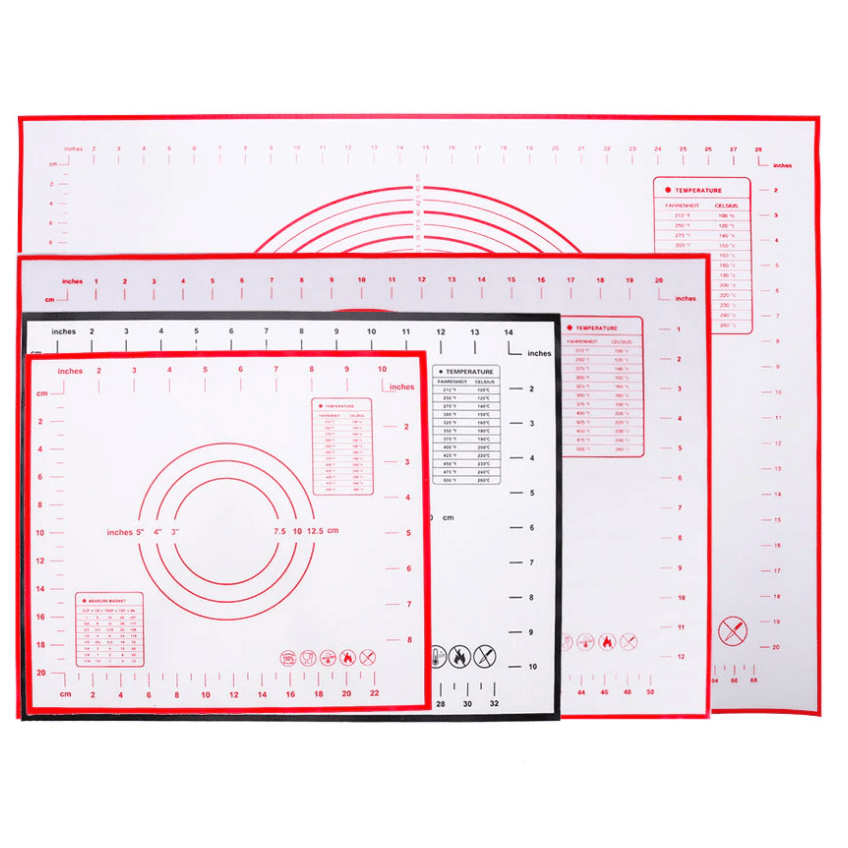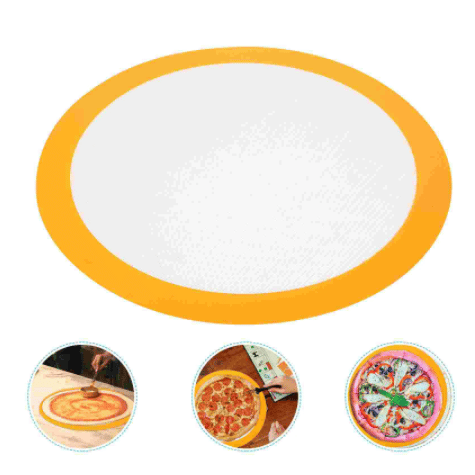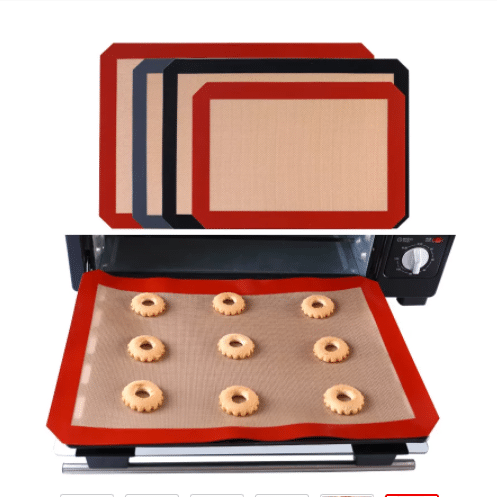Why Does My Silicone Baking Mat Smell?
Silicone baking mats have become a popular choice for baking enthusiasts due to their non-stick surface, durability, and reusability. However, some users may experience unpleasant odors from their silicone baking mats, which can affect the quality of their baked goods. In this article, we will discuss the composition and properties of silicone baking mats, the causes of odor, strategies for reducing and eliminating odor, and when to replace them.
Silicone Baking Mats: Composition And Materials
What is silicone baking mats?
Silicone baking mat is a baking tool made of silicone material, which is mainly used to prevent food from sticking and evenly heating during baking.
The befinets of Silicone baking mat:
High temperature resistance: Silicone baking mat can withstand high temperature baking, usually up to 482°C, ensuring that it will not deform or age during baking
Anti-stickiness: The surface of silicone baking mat is smooth, which can effectively prevent food from sticking and reduce cleaning work
Environmentally friendly and sustainable: Compared with disposable baking paper and aluminum foil, silicone baking mat can be reused, reducing the generation of plastic waste and being more environmentally friendly
Easy to clean: Silicone baking mat is easy to clean and care for, and is easy to use
Non-toxic and odorless: Food-grade silicone material ensures safety and non-toxicity during use, and will not release harmful substances
Silicone baking mats are made of two main materials: food-grade silicone and fiberglass mesh reinforcement. Food-grade silicone is a type of silicone rubber that is safe for contact with food and can withstand high temperatures up to 480°F (250°C). It is flexible and has a non-stick surface that makes it easy to remove baked goods without using additional oil or cooking spray. Fiberglass mesh reinforcement is embedded into the silicone to provide additional support and prevent the mat from tearing or warping. The inner mesh is made of a thin layer of fiberglass that is coated with silicone to make it heat-resistant and non-stick.
Properties of Food-grade Silicone:
Food Grade Silicone Article:
-
What Is Food Grade Silicone-A safe, durable and environmentally friendly new favorite in the kitchen
-
What Is the Difference Between Food-Grade Silicone and Regular Silicone?
-
What Is the Difference Between Food Grade and Medical Grade Silicone?
-
what does food-grade silicone do?
-
The best way to tell the difference of LFGB and FDA food silicone products?
-
How to test food-grade silicone?
-
How to distinguish food-grade silicone?
-
How to distinguish ordinary silicone and food-grade silicone products?
-
How safe is using food-grade silicone in baking and high temperatures?
-
How Safe Is Silicone For Food Storage
Causes of Silicone Baking Mat Odor
Silicone baking mats may produce unpleasant odors due to several reasons, including the use of lower-quality silicone materials, residual manufacturing by-products, accumulation of food residues and oils, and exposure to high temperatures.
Lower-quality Silicone Materials
Use of fillers or additives that may produce odors when heated. Some manufacturers may use fillers or additives in silicone baking mats to reduce production costs or enhance certain properties. Fillers can include various materials such as talc, calcium carbonate, or even other types of plastics. Additives can be used to adjust color, elasticity, or other characteristics of the silicone material. When heated, these fillers or additives can release odors that affect the overall baking experience.
Incomplete curing process resulting in residual chemicals. Curing is a crucial step in the manufacturing process that involves heating the silicone to solidify it. The curing process transforms the silicone into a stable, flexible, and heat-resistant material suitable for baking. Proper curing ensures that all chemicals involved in the process are thoroughly reacted and any residual by-products are eliminated. Incomplete curing can result in residual chemicals being present in the silicone baking mat, which may produce odors when the mat is heated during baking.
Residual Manufacturing By-Products
Presence of solvents or other chemicals from production. During the manufacturing process of silicone baking mats, solvents or other chemicals may be used that can leave residual by-products on the mat. These by-products can produce unpleasant odors when the mat is heated.
Inadequate cleaning prior to packaging. If the mats are not cleaned thoroughly before packaging, residual chemicals or manufacturing by-products may remain on the surface of the mat, leading to unpleasant odors.
Accumulation of Food Residues and Oils
The buildup of cooking oils, fats, and food particles over time. Food residues and oils can accumulate on the surface of the mat over time, especially if it is not cleaned thoroughly after each use. These residues can become rancid and produce unpleasant odors when the mat is heated.
Bacterial growth and spoilage lead to unpleasant odors. If the mat is not cleaned properly or stored in a damp or humid environment, it may be prone to bacterial growth and spoilage. This can lead to unpleasant odors emanating from the mat.
Exposure to High Temperatures
Degradation of silicone materials at temperatures above recommended limits. If the mat is exposed to high temperatures above the recommended limits, the silicone material may degrade and release unpleasant odors.
Release of volatile organic compounds (VOCs) as a result of overheating. Overheating the mat can also release volatile organic compounds (VOCs) that can produce unpleasant odors and be harmful to health.
Strategies for Reducing and Eliminating Odor
To reduce and eliminate odors from silicone baking mats, users can employ various strategies, including selecting high-quality mats, proper initial cleaning and preparation, regular cleaning and maintenance, and storage and handling considerations.
Selecting High-Quality Silicone Baking Mats
Look for mats made from 100% food-grade silicone. To ensure the mat is made of high-quality materials, look for mats made from 100% food-grade silicone. This ensures that the mat is safe from contact with food and can withstand high temperatures.
Check for FDA approval or similar certifications. Check if the mat has been approved by the Food and Drug Administration (FDA) or similar regulatory bodies. This can indicate that the mat has undergone rigorous testing and meets safety and quality standards.
Further Reading: The Best Way To Tell The Difference Of LFGB And FDA Food Silicone Products?
Proper Initial Cleaning and Preparation
Wash the mat with warm soapy water before first use. Before using the mat for the first time, wash it with warm soapy water to remove any residual manufacturing by-products or chemicals.
Rinse thoroughly and allow to air dry. After washing, rinse the mat thoroughly with water and allow it to air dry before using it.
Further Reading: the ultimate guide to cleaning silicone mats
Further Reading: Cleaning Silicone Mats
Regular Cleaning and Maintenance
Clean the mat after each use with warm soapy water and a soft sponge. After each use, clean the mat with warm soapy water and a soft sponge. This will remove any food residues and oils that may have accumulated on the surface of the mat.
Avoid using harsh chemicals or abrasive scrubbers that may damage the mat’s surface. Avoid using harsh chemicals or abrasive scrubbers that can damage the surface of the mat. This can affect the non-stick properties of the mat and lead to unpleasant odors.
Allow the mat to air dry or dry with a clean towel. After cleaning, allow the mat to air dry or dry it with a clean towel before storing it.
Storage and Handling Considerations
Store the mat flat or gently rolled to prevent creasing or damage to the silicone material and fiberglass mesh.
Avoid folding the mat, as this can cause permanent damage and compromise its performance.
Keep the mat in a cool, dry place away from direct sunlight or heat sources, as excessive heat or sunlight can degrade the silicone over time.
When to Replace a Silicone Baking Mat
Despite proper cleaning and care, silicone baking mats may need to be replaced when they show signs of wear and tear, persistent odors, or when they no longer perform as expected.
Signs of Wear and Tear
Discoloration or staining that does not come off with cleaning. If the mat shows signs of discoloration or staining that cannot be removed with cleaning, it may be time to replace it. This can indicate that the mat has been used extensively and is no longer in good condition.
Cracks, tears, or frayed edges in the silicone or fiberglass mesh. If the mat has cracks, tears, or frayed edges in the silicone or fiberglass mesh, it may no longer be effective in providing a non-stick surface and may need to be replaced.
Persistent Odors Despite Proper Cleaning and Care
Unpleasant smells that remain even after thorough cleaning. If the mat continues to produce unpleasant odors even after thorough cleaning, it may be time to replace it. This can indicate that the mat has accumulated too much buildup of food residues and oils, or that it has been exposed to high temperatures that have caused the silicone material to degrade.
Odors that intensify when the mat is heated. If the odors intensify when the mat is heated, this can indicate that the mat has degraded and is releasing volatile organic compounds (VOCs). This can be harmful to health and the mat should be replaced immediately.
Manufacturer’s Recommendations for Lifespan and Usage
Follow guidelines provided by the manufacturer regarding the mat’s expected lifespan. Manufacturers may provide guidelines on the expected lifespan and usage of silicone baking mats. Follow these guidelines to ensure that the mat is used properly and does not degrade prematurely.
Replace the mat if it no longer performs as expected or if odors persist. If the mat no longer performs as expected or odors persist despite proper cleaning and care, it may be time to replace it. A new silicone baking mat will provide a safe and effective non-stick surface for baking, without producing unpleasant odors.
Conclusion
Silicone baking mats are a versatile and practical tool for baking enthusiasts, providing a non-stick surface that is easy to clean and reuse. However, they may produce unpleasant odors if not cared for properly. The causes of odor include the use of lower-quality silicone materials, residual manufacturing by-products, accumulation of food residues and oils, and exposure to high temperatures. To reduce and eliminate odors, users can select high-quality mats, clean and maintain them properly, and replace them when necessary. By following these strategies, users can ensure that their silicone baking mats remain safe, effective, and odor-free, providing an enjoyable baking experience for years to come.
Contact Z.S.R to branded your silicone baking mats now!
Technical Related
About Author: Z.S.R International Group
Z.S.R International Group(Hong Kong) co., Limited, is a one-stop supplier for molded silicone products and silicone products molding solution provider in the consumer products field. We offer OEM services from silicone product design to Silicone products contract manufacturing. We have the capability for custom silicone tooling, LSR(Liquid silicone Rubber) molded silicone products, solid silicone molded products, molded silicone multi-colored products. We also can custom molded silicone, custom molded LSR, custom molded dripping injection dispensing(co-injection) silicone multi-colored products.





